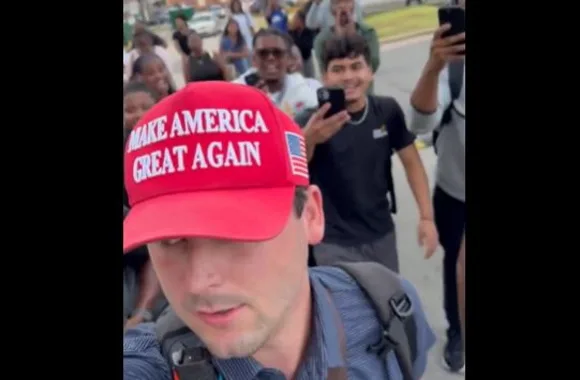Videos circulating online show a tense moment at a Tennessee college when a conservative debate group was surrounded by a large cluster of students and then removed from campus. The footage captures shouts, close proximity, and vocal confrontation that prompted university officials to step in. Campus authorities ultimately escorted the group away to defuse the situation and restore order.
The group said their goal was to spark campus debate and to honor a conservative commentator’s influence with public discussions, while critics said the gathering was unapproved and inflammatory. Observers pointed to partisan apparel and provocative signage as elements that escalated tensions in a community already sensitive to political displays. That mix of intent and optics created an environment where calm conversation became difficult in minutes.
Witness accounts and onlookers uploaded snippets to social platforms, turning a localized disagreement into a broader conversation about how colleges handle polarizing visitors. The incident landed squarely in the center of perennial questions about safety, free expression, and who gets to set the terms of campus discourse. University personnel have said they acted to prioritize student welfare while seeking clarity about event permissions.
Campus Reaction And Issues
Students who confronted the group described themselves as protecting campus space from what they regarded as a hostile, uninvited presence. Others on campus argued that preventing the discussion crossed a line into silencing views they disagree with, intensifying the debate about acceptable protest tactics. Both sides reported feeling under threat, either from rhetoric or from the possibility that dissenting voices would be drowned out.
Administrators now face pressure to explain whether the appearance was authorized, whether advance notice was given, and how similar situations will be managed going forward. There is a growing chorus calling for transparent, consistent policies that distinguish between permitted demonstrations and unauthorized disruptions. At the same time, some faculty members urge that clear expectations for civil engagement be paired with better conflict-deescalation training for campus security.
The incident also highlights a trend where social media amplifies campus confrontations and converts them into national talking points almost instantly. Short clips rarely capture context, and heated moments can be portrayed as emblematic of broader cultural battles. That speed and selectivity make measured response harder and escalate pressure on universities to act quickly even before full facts are known.
Legal experts say colleges must balance competing obligations: safeguard students, protect lawful expression, and enforce campus policies fairly. Poorly handled enforcement risks accusations of bias from all sides, while inconsistent punishment undermines trust in institutional leadership. A robust process for granting event approvals and clear channels for reporting concerns would reduce ad hoc, emotionally driven responses.
Going forward, stakeholders on campus—students, staff, and outside speakers—need a shared commitment to rules that enable spirited but safe debate. Organizers who want to hold public discussions should seek permissions and work with campus liaisons to set expectations and logistics. Protesters have a role to play too, by choosing tactics that register dissent without shutting down conversation entirely.
The removal of the group was an immediate solution to a charged moment, but it leaves unresolved questions about how similar encounters should be handled. If campuses are to be places where contested ideas meet, they must adopt clearer protocols, better communication, and a culture that tolerates disagreement without resorting to intimidation. Until then, episodes like this will keep surfacing, forcing communities to confront the uncomfortable trade-offs between free expression and communal safety.

